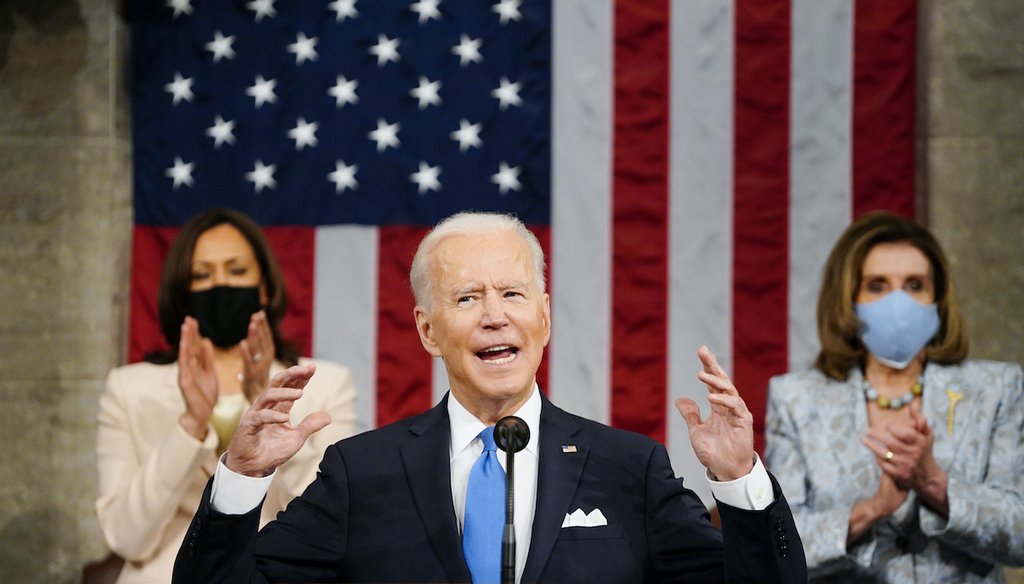Stand up for the facts!
Our only agenda is to publish the truth so you can be an informed participant in democracy.
We need your help.
I would like to contribute

Vice President Kamala Harris, and House Speaker Nancy Pelosi of Calif., stand and applaud as President Joe Biden addresses a joint session of Congress, Wednesday, April 28, 2021, in the House Chamber at the U.S. Capitol in Washington. (AP)
In his first speech before Congress, President Joe Biden argued it was time to turn the coronavirus pandemic into a historic opportunity to expand government for the benefit of a wider range of Americans, urging investments in jobs, climate change, child care, infrastructure and more.
Biden said that taxes should be increased on corporations and the wealthy to pay for new spending, as well as to address escalating inequality.
"My fellow Americans, trickle-down economics has never worked. It’s time to grow the economy from the bottom up and middle out," Biden said.
Join PolitiFact LIVE on May 10-13 for a festival of fact-checking with Dr. Anthony Fauci! Register today >>
He repeatedly urged Congress to act on a variety of measures, including issues like gun control and immigration that have frozen Congress for decades. He said police reforms proposed in the wake of the death of George Floyd should be enacted and specifically urged bipartisan consensus.
"I know the Republicans have their own ideas and are engaged in productive discussions with Democrats. We need to work together to find a consensus," Biden said.
The coronavirus pandemic limited the audience to 200 masked and distanced members of Congress and other officials, down from a typical audience of about 1,600.
Only two members from the president’s Cabinet were invited: Secretary of State Antony Blinken and Defense Secretary Lloyd Austin. Chief Justice John Roberts represented the Supreme Court. First lady Jill Biden’s guests were invited to watch the event virtually.
And for the first time in U.S. history, two women sat directly behind the president as he delivered his speech — House Speaker Nancy Pelosi, D-Calif., and Vice President Kamala Harris.
"Madam vice president," Biden said. "No president has ever said those words, and it is about time."
For the most part, Biden’s statements about his progress and future plans traced to estimates from think tanks or government data. In some cases, he exaggerated or left out information that would give Americans a full picture.
We fact-checked Sen. Tim Scott's response for the GOP in this story.
"The economy created more than 1.3 million new jobs in 100 days, more new jobs in the first 100 days than any president on record."
This is basically accurate, although Biden sidestepped a grimmer statistic: The current employment level remains 6.72 million jobs below its pre-pandemic level.
The Bureau of Labor Statistics counted 144.1 million Americans as employed in non-farm positions in March 2021, up from 142.7 million in January 2021, when Biden was sworn in. That’s an increase of almost 1.4 million jobs, or an increase of about 1% from January to March.
Biden’s increases, by both number and percentage, are bigger than any post-war, regularly elected president. (This doesn’t count presidents who took office suddenly without being elected.)
The second-place finisher in both categories, Jimmy Carter, had an increase in raw numbers that was about half as big as Biden’s, 701,000. Carter’s percentage increase of 0.9% was just shy of Biden’s mark so far.
Biden has benefited from the updraft from the economic recovery after the worst of the coronavirus pandemic. But that’s not an unusual circumstance: Only one president, Obama, had his first 100 days occur during a spiraling economic downturn, and it shows in the early job losses on his watch. Every other president in our comparison was fortunate enough to have their first 100 days either fully or partly in a rising economic phase.
Finally, it’s worth noting that job creation can be affected by presidential policies, but they are just one factor.
"When I was vice president, the president asked me to focus on providing help needed to address the root causes of migration. And it helped keep people in their own countries instead of being forced to leave. The plan was working, but the last administration decided it was not worth it."
This is exaggerated. The Obama administration in 2014 approved more aid to Central American countries to tackle issues causing people to migrate to the United States. The Trump administration proposed cuts to that aid, and annual funding for the strategy declined from $750 million in fiscal year 2017 to $505.9 million in fiscal year 2021.
Amid increased migration in 2019, the Trump administration suspended aid while it negotiated asylum agreements with El Salvador, Honduras and Guatemala. By 2020, U.S. agencies restored the once-suspended aid, according to the Congressional Research Service.
There’s limited information on how U.S. assistance has improved conditions in Central America and U.S. agencies have reported mixed results for some projects. Immigration experts have said that it takes time to see the impact of foreign assistance. While aid might have kept some people in their home countries, it didn’t stop all migration from Central America.
"In the 1990s, we passed universal background checks and a ban on assault weapons and high-capacity magazines that hold 100 rounds that can be fired in seconds. … Mass shootings and gun violence declined. But in the early 2000s, that law expired, and we’ve seen the daily bloodshed since."
The data on this question varies significantly, but some studies have found evidence supporting Biden’s assertion.
The 1994 law, part of an anti-crime package authored by then-Sen. Biden, banned the "manufacture, transfer and possession" of certain semiautomatic firearms classified as assault weapons, as well as certain high-capacity ammunition magazines of more than 10 rounds.
A 2016 book by Louis Klarevas, research professor at Columbia University’s Teachers College, looked at incidents over three decades — before, during and after the 1994 ban — in which six or more people were shot and killed, not including the perpetrators.
In the decade before the 1994 ban, there were 19 such incidents. During the decade with the ban in effect, there were 12 incidents. In the decade after the ban expired, there were 34 incidents.
In addition, two researchers whose earlier analyses were more uncertain about the legislation’s real-world impact have released more recent papers suggesting that the ban, especially the one on high-capacity magazines, had an impact on reducing gun deaths.
However, a 2020 review of past studies by the RAND Corp. found "inconclusive evidence for the effect of assault weapon bans on mass shootings."
"There’s a broad consensus of economists — left, right, center — and they agree that what I’m proposing will help create millions of jobs and generate historic economic growth."
This is exaggerated. Many economists support Biden’s proposals, but there are also some notable dissenters.
Critics have expressed concerns about the package’s size and timing, saying it was passed late in the pandemic, when an economic upturn was in sight. "There’s a danger of overheating the economy" from injecting so much spending, Douglas Holtz-Eakin, president of the center-right American Action Forum, told PolitiFact.
And Daniel Mitchell, a libertarian economist told PolitiFact that the package "belongs in the category of bad policy."
Typically, these concerns redoubled after Biden proposed a $2.65 trillion infrastructure plan. Conservative economists have expressed particular concern about the corporate tax hikes that Biden intends to use to pay for the new spending.
And the concerns are not only being expressed on the right. Larry Summers, the economist who held top positions for Democratic presidents Bill Clinton and Barack Obama, said Biden’s large-pricetag proposals were risky, potentially spurring inflation.
The recession caused by the coronavirus pandemic was "the worst economic crisis since the Great Depression."
Two key metrics back this up.
The biggest economic hit since the Great Depression in the 1930s was generally considered to be the Great Recession between 2007 and 2009, but the recession caused by the pandemic packed a bigger punch.
The peak unemployment rate in the Great Recession was 10% in October 2009, but that pales compared with the peak unemployment rate during the pandemic, 14.8% in April 2020.
And the quarterly decline in gross domestic product was 8.4% in the fourth quarter of 2008, but that was just a fraction of the 31.4% decline in the second quarter of 2020.
"Nearly 90% of the infrastructure jobs created in the American Jobs Plan don’t require a college degree. 75% don’t require an associate’s degree."
The White House based his claim on an analysis by the Georgetown University Center on Education and the Workforce. The analysis, which looked at $1.5 trillion of spending within Biden’s infrastructure proposal, comes with caveats.
First, different people count different things as infrastructure, and calling $1.5 trillion of the proposal "infrastructure" is one of the more generous definitions. Still, we found at least $683 billion of the proposal clearly qualifies under a traditional definition of infrastructure.
Second, no bill has been written yet; a final version could include significant changes.
That said, the analysis found that 16% of the jobs would require less than a high school degree, another 37% would require a high school degree, 14% would require some college but no degree, 8% would require a secondary vocational certificate, and 10% would require a two-year associate's degree.
All together, that's 85% of the jobs that don't require a bachelor's degree, which is close to the 90% that Biden cited. And 75% of the jobs would not require an associate’s degree or higher, which is what Biden said.
"Thanks to the American Rescue Plan, we are on track to cut child poverty in America in half this year."
No one can predict the future, but experts say the analyses undergirding Biden’s assertion are credible. However, the drop in child poverty only lasts for one year because the benefits will expire under current law.
Biden’s idea builds on an existing $2,000 child tax credit but expands it for lower- and middle-income families. The idea is that this additional monthly income would push many American families over the poverty line.
The primary evidence usually cited by backers is a January analysis by Columbia University’s Center on Poverty and Social Policy. According to the analysis, Biden’s proposal would cut the overall poverty rate to 9% from 12.6%, and by larger amounts for some subgroups. For children, the poverty rate would fall to 6.6% from 13.4%, which is where the "cut by half" language comes from. For Black families, it would fall to 13.3% from 20.3%. Hispanic families would see the largest decline of all, from 18.9% to 11.4%.
"Let’s raise the minimum wage to $15. No one working 40 hours a week should live below the poverty line."
This lacks context. Whether a person earning below $15 an hour is living in poverty depends upon various factors, including the size of their household.
The White House previously pointed to an example of a family of four with one full-time income using the federal government’s poverty guideline. Using that measurement, that family with a paycheck of $13 an hour would live below the poverty line. At $15 an hour, the same family would be above the poverty line.
Experts say generalizing a "poverty wage" to a specific number ignores the different circumstances that families face. Other experts said the federal definition of a poverty level is out of date and needs changing.
Since 2009, the federal minimum wage has been $7.25 an hour, though 29 states and Washington D.C. have higher minimum wages, as do some cities and counties.
"During these 100 days, an additional 800,000 Americans enrolled in the Affordable Care Act when I established a special sign-up period to do that. 800,000 in that period."
This appears accurate but needs context.
Biden did create a special enrollment period for Americans to sign up for health insurance through the Affordable Care Act marketplace plans, due to the COVID-19 pandemic. That special enrollment period began Feb. 15 and will run through Aug. 15. According to numbers released by the Department of Health and Human Services, 528,000 Americans enrolled in health insurance coverage since that special enrollment period began through March 31. A senior administration official said that Biden’s reference to the 800,000 new sign-ups reflected the most up-to-date tally, though it hasn’t been previously announced.
"When I was sworn in on Jan. 20, less than 1% of seniors in America were fully vaccinated against COVID-19. One hundred days later, 70% of seniors over 65 are protected. Senior deaths from COVID-19 are down 80% since January."
This is largely accurate.
According to the Centers for Disease Control and Prevention’s Data Tracker, 0.8% of those over age 65 had been vaccinated on Jan. 20. So Biden is correct on this point.
However, when Biden took office, the U.S. vaccination program had only been in place for about a month — the Pfizer-BioNTech and Moderna vaccines weren’t authorized for emergency use until mid-December. And initial recommendations from the independent Advisory Committee on Immunization Practices prioritized vaccination of health care workers, and then long-term care facility residents. The next two phases included people 75 and and older and then 65 and older, meaning that some states may not have started vaccinating these age groups until mid-January.
As of April 28, the CDC reported the number of those over age 65 who have received both doses of the COVID-19 vaccine and are fully protected is nearly 70% — it’s at 68.3%. The percent who have received at least one dose is actually higher: 82%.
A senior administration official provided CDC mortality data for all Americans, but not statistics specifically about seniors. That data shows the COVID-19 daily death rate dropped by nearly 80% from Jan. 20 to April 27. Based on additional, age-specific CDC data provided April 29 by the White House, the overall decrease in the daily death rate for people older than 65 was between 92% and 95% – an improvement better than what Biden cited in his speech. (Note: This section was updated to clarify the data.)
The Associated Press reported on April 22 that the best available data appeared to show COVID-19 deaths for those 65 and older had declined by more than 50% since a peak in January, but said the "picture is not entirely clear because the most recent data on deaths by age from the Centers for Disease Control and Prevention is incomplete and subject to revision."
"We won’t ignore what our intelligence agencies have determined to be the most lethal terrorist threat to the homeland today: white supremacist terrorism."
We’ve rated a similar claim True. FBI director Christopher Wray has told lawmakers that a significant number of domestic terrorism investigations involved racially-motivated, violent extremist-motivated terrorist attacks.
"Racially-motivated violent extremists over recent years have been responsible for the most lethal activity in the U.S.," Wray said in September 2020. "Now this year, the domestic terrorism, lethal attacks we’ve had have, I think, all fit in the category of anti-government, anti-authority, which covers everything from anarchist violent extremists to militia types. We don’t really think in terms of left, right."
In 2019, Wray said, "And the majority of those, of the racially-motivated, violent extremist attacks, are fueled by some kind of white supremacy. And I would say that the most lethal activity over the last few years has been committed by those type of attackers."
Earlier this year, the Office of the Director of National Intelligence, the Justice Department and the Department of Homeland Security released an unclassified summary of an assessment on domestic violent extremism. The summary said that U.S. racially or ethnically motivated violent extremists "who promote the superiority of the white race" are the domestic violent extremists "with the most persistent and concerning transnational connections," because people with similar ideological beliefs exist outside of the U.S. and frequently communicate with and seek to influence each other.
"A recent study shows that 55 of the nation’s biggest corporations paid zero in federal income tax last year."
This is Mostly True, backed by an April 2 study by the liberal-leaning Institute on Taxation and Economic Policy.
Some critics say the financial disclosures used to compile the report are imperfect estimates of what the companies actually paid in taxes, because the accounting rules are different for the two types of filings.
However, separate data from the Joint Committee on Taxation, which is based on actual tax returns, has supported the study’s general point.
"Decades ago we used to invest 2% of our GDP on research and development. Today, that’s less than 1%."
This is accurate. Data from the National Science Foundation shows that federal spending as a percentage of gross domestic product hit a high of almost 1.9% in 1964 and has generally fallen since then, to 0.6% in 2017, the most recent year for which the foundation has complete data.
RELATED: Fact-checking Tim Scott's GOP response to Joe Biden
Our Sources
See linked resources.
New York Times, Biden Orders $15 Minimum Wage for Federal Contractors, April 27, 2021
PolitiFact, Fact-checking Joe Biden’s claim about $15 minimum wage and poverty, Feb. 10, 2021
White House, Executive Order on Increasing the Minimum Wage for Federal Contractors, April 27, 2021
White House, FACT SHEET: Biden-Harris Administration Issues an Executive Order to Raise the Minimum Wage to $15 for Federal Contractors, April 27, 2021











































